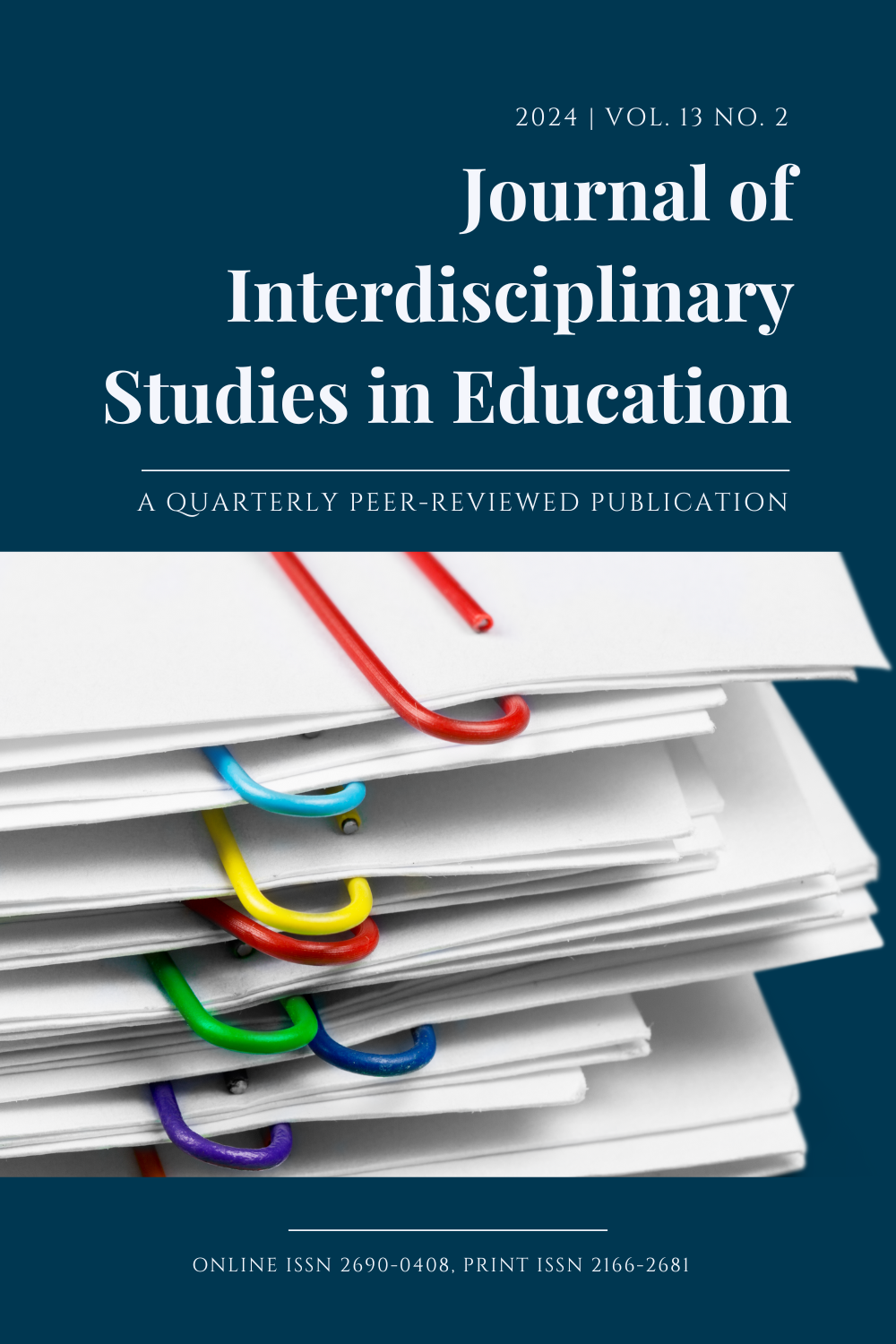Differences in the reading performance of Texas grade 4 boys enrolled in Title I, part A and non-Title I, part A schools
A multiyear analysis
DOI:
https://doi.org/10.32674/dnb4bs68Keywords:
Title I Schools, Part A STAAR Reading; Grade 4; Approaches Grade Level Performance; Meets Grade Level Performance; Masters Grade Level PerformanceAbstract
In this investigation, the reading performance of Texas Grade 4 boys was compared by their enrollment or non-enrollment in Title I, Part A schools. Data were obtained from the Texas Education Agency Public Education Information Management System for all Grade 4 boys in Texas who took the State of Texas Assessment of Academic Readiness assessment in the 2016-2017, 2017-2018, and 2018-2019 school years. Inferential statistical analyses revealed the presence of statistically significant differences in all three school years. Boys enrolled in non-Title I, Part A schools outperformed boys enrolled in Title I, Part A schools in all three Reading Reporting Categories and in all three grade level standards. Recommendations for research and implications for policy and practice are suggested.
Downloads
References
Bernadowski, C. (2016). “I can’t evn get why she would make me rite in her class:” Using think-alouds in middle school math for “at-risk” students. Middle School Journal, 47(4), 3-14. https://doi.org/10.1080/00940771.2016.1202654
Cohen, J. (1988). Statistical power analysis for the behavioral sciences (2nd ed.). Lawrence Erlbaum.
Field, A. (2018). Discovering statistics using SPSS (5th ed.). Sage.
Garrett-Peters, P. T., Mokrova, I., Vernon-Feagans, L., Willoughby, M., & Pan, Y. (2016). The role of household chaos in understanding relations between early poverty and children’s academic achievement. Early Childhood Research Quarterly, 37, 16-25. https://doi.org/10.1016/j.ecresq.2016.02.004
Hamilton, H. A. (2020). Reading performance and economic status of Texas Grade 3 underrepresented students: A multiyear, statewide investigation. Doctoral Dissertation, Sam Houston State University, Huntsville, TX.
Hamilton, H. A., & Slate, J. R. (2019). Differences in Grade 3 reading by the economic status of students of color: Much cause for concern. Asian Journal of Interdisciplinary Research, 2(4), 97-104. https://doi.org/10.34256/ajir19410
Harris, L. (2018). Differences in the reading performance of Texas Grade 4 students as a function of their economic status, gender, and ethnicity/race: A multiyear, statewide investigation. Doctoral Dissertation, Sam Houston State University, Huntsville, TX.
Hernandez, D. J. (2012). Double jeopardy: How third grade reading skills and poverty influence high school graduation. The Annie E. Casey Foundation. https://assets.aecf.org/m/resourcedoc/AECF-DoubleJeopardy-2012-Full.pdf
Johnson, R. B., & Christensen, L. (2020). Education research: Quantitative, qualitative, and mixed methods approaches (7th ed.). Sage.
Kleinfeld, J. (2009). The state of American boyhood. Gender Issues, 26(1), 113-129. https://doi.org/10.1007/s12147-009-9074-z
Loveless, T., & Brookings Institution, B. C. on E. P. (2015). The 2015 Brown Center Report on American Education: How Well Are American Students Learning? With Sections on the Gender Gap in Reading, Effects of the Common Core, and Student Engagement. Volume 3, Number 4. Brookings Institution.
McGown, J. A. (2016). Differences in reading performance of Texas elementary school students as a function of economic status, gender, and ethnicity/race: A multiyear statewide study. Doctoral Dissertation, Sam Houston State University, Huntsville, TX.
Pariseau, M. M. (2019). Differences in reading as a function of the economic status, ethnicity/race, and English learner status of Texas Grade 4 boys and girls in special education: A multiyear statewide investigation. Doctoral Dissertation, Sam Houston State University, Huntsville, TX.
PEIMS Data Standards. (2018). Public Education Information Management System Overview. https://tea.texas.gov/Reports_and_Data/Data_Submission/PEIMS/PEIMS_-_Overview/
Reardon, S. F. (2013). The widening income achievement gap. Educational Leadership, 70(8), 10-16.
Reardon, S. F., Fahle, E. M., Kalogrides, D., Podolsky, A., & Zárate, R. M. (2019). Gender achievement gaps in U. S. school districts. American Educational Research Journal, 56(6), 2474-2508. https://doi.org/10.3102/0002831219843824
Slate, J. R. (2023a). Advanced statistical analyses: How to perform them and how to write them up in an understandable manner: A primer for graduate students, faculty, and educational leaders. ICPEL Publications. International Council of Professors of Educational Leadership. https://www.lulu.com/shop/john-slate/advanced-statistical-analyses-how-to-perform-them-and-how-to-write-them-up-in-an-understandable-manner/paperback/product-jkwzqy.html?q=John+Slate&page=1&pageSize=4
Texas Education Agency. (2015). Glossary of terms. https://rptsvr1.tea.texas.gov/acctres/gloss0708.html
Texas Education Agency. (2017). State of Texas Assessments of Academic Readiness (STAAR) performance labels and policy definitions. https://tea.texas.gov/sites/default/files/STAAR_Performance_Labels_and_Policy_Definitions.pdf
Texas Education Agency. (2019). 2019 Accountability Manual. Austin, TX: Author. https://tea.texas.gov/sites/default/files/Chapter%204%202019%20Closing%20the%20Gaps%20Domain_adopted.pdf
Texas Education Agency. (2021a). Enrollment in Texas public schools 2020-21. https://tea.texas.gov/sites/default/files/enroll-2020-21.pdf
Texas Education Agency. (2021b). FRPL income eligibility chart. https://tea.texas.gov/sites/default/files/frpl-income-eligibility-chart.pdf
Texas Education Agency (2022). Title I, Part A – improving basic programs. https://tea.texas.gov/finance-and-grants/grants/essa-program/title-i-part-a-improving-basic-programs
United States Census Bureau. (2017). Race and ethnicity. https://www.census.gov/mso/www/training/pdf/race-ethnicity-onepager.pdf
United States Census Bureau. (2022). Poverty in the United States: 2021. https://www.census.gov/library/publications/2022/demo/p60-277.html#:~:text=The%20official%20poverty%20rate%20in,and%20Table%20A%2D1).
United States Department of Education. (2017). Every Student Succeeds Act. https://www.ed.gov/esea
United States Department of Education. (2018). Improving basic programs operated by local educational agencies (Title I, Part A). https://www2.ed.gov/programs/titleiparta/index.html
Watts, C. T. (2022). The correlation between poverty and reading success in children’s early years. The Reading Professor, 45(1), 1-17. https://scholar.stjohns.edu/cgi/viewcontent.cgi?article=1151&context=thereadingprofessor
Zhang, J., Li, M., Yee, D., Park, B. J., Bohrnstedt, G., & Broer, M. (2020). Reading motivation, reading achievement, and reading achievement gaps: Evidence from the NAEP 2015 reading assessment (AIR-NAEP Working Paper No. 2020-01). https://eric.ed.gov/?id=ED610318
Additional Files
Published
Issue
Section
License
Copyright (c) 2024 Dr. Rodriguez, Dr. Slate

This work is licensed under a Creative Commons Attribution-NonCommercial-NoDerivatives 4.0 International License.







